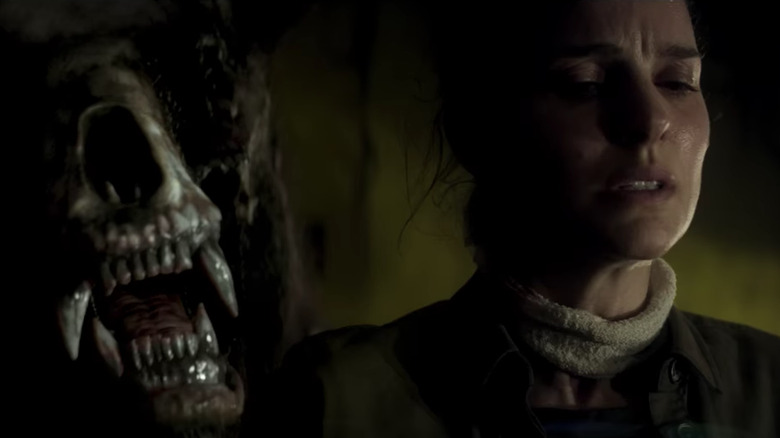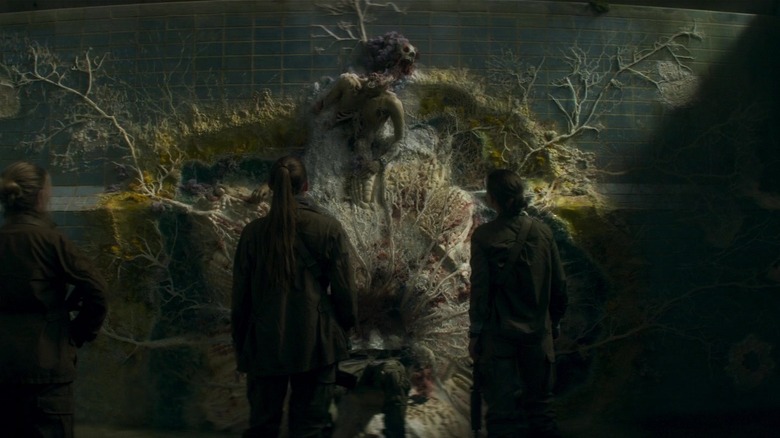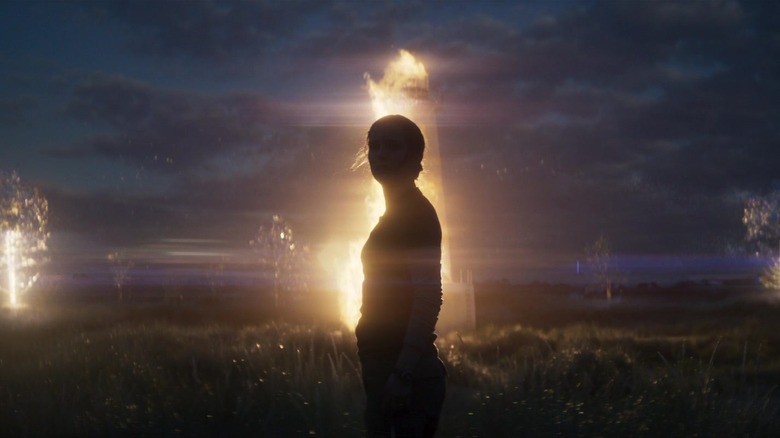The Ending Of Annihilation Explained
Filming a mind-bending dystopian movie that stays fairly underrated is a rite of passage in Hollywood, and Natalie Portman's career has been no exception. In 2018, Portman appeared as biologist Lena in Alex Garland's "Annihilation," throwing her into a world of hallucinations, mutant creatures, and a mystery that seems to have no tangible answer. We follow Lena as she tries to get to the bottom of how her husband (Oscar Isaac) died, as she becomes entangled with a world that's far removed from reality alongside the lives of the four other women also venturing into the unknown.
Opening to a meek $11 million during its first weekend in theaters, "Annihilation" has since been a film that's stayed under the radar but has never left the minds of those who have watched it. Fans appreciate that the concept of the movie is unique, while the unknown threats of "the Shimmer" the characters venture into make every moment on screen all the more terrifying. For many, the film's ending has been something that can never be fully explained — but even so, we're going to try our best to do it anyway. Don't lose your mind while we break down the ending of "Annihilation" in full.
What you need to remember about the plot of Annihilation
Natalie Portman plays biologist and former soldier Lena, who signs up for a mission intent on finding out what happened to her husband, Kane, in a site known as Area X. She's joined by four other women who each specialize in their own scientific field, and the four set off to explore the largely uncharted territory known as the Shimmer. As "Annihilation" begins, viewers learn that Lena is the only one who has made it out alive, having to answer for what exactly happened while the group was there.
From the moment they set foot in the Shimmer, the group is accosted and attacked by mutated creatures and the hostile landscape. Their equipment no longer works while in the zone, either. At an abandoned military base, Lena finds more clues that reveal what happened to her husband. With their mental states changing dramatically while spending more time in the Shimmer, the women begin to die one by one — mostly at the hands of a mutant bear before physicist Josie (Tessa Thompson) is able to shoot it. As Lena learns more about the area, she realizes that Ventress (Jennifer Jason Leigh), the psychologist who set up the expedition after Kane's admission to the ICU, might know more than she's letting on.
What happened at the end of Annihilation
After the mutant bear is no longer a threat, Lena follows Ventress to the center of the Shimmer, where she explains that the area will eventually swallow itself. The pair then finds more video footage documenting Kane's end. He leaves cryptic instructions to find Lena before killing himself with a phosphorus grenade. Viewers then see a doppelgänger of Kane appear on the tape, but not before Ventress disintegrates into thin air. In her place is a shimmering cloud, which absorbs a drop of Lena's blood to create a faceless creature.
The creature mimics Lena's movements, not letting her leave and striking her when she lashes out at it. Unable to escape, Lena tricks the creature into igniting a leftover grenade as the creature transforms into her own doppelgänger. The center of the Shimmer deteriorates while Lena flees the burning wreckage, saving herself. A little while later, Lena pays Kane's doppelgänger a visit, trying to find out if he is the real version of her husband or not. She asks, "Are you Kane?" and the man, who may or may not be her husband, says he doesn't know. He replies, "Are you Lena?" And she cannot provide an answer. In their joint confusion, the two embrace as the film closes.
The Shimmer is an alien force
From the start of the film, the characters of "Annihilation" — and the audience — are wondering, "What is the Shimmer?" Answers are alluded to in the film's opening shots, which show some sort of interstellar object careening through Earth's atmosphere and crashing into a lighthouse. That lighthouse is both the focus and the destination for the excursions into the Shimmer organized by the military and researchers in Area X (the land surrounding the Shimmer). While by now, we know the Shimmer comes from space, we don't actually know what it is.
The Shimmer, as it turns out, is some sort of alien force. It's sentient — a living, breathing thing that is ultimately tied to an alien being that we see take on a humanoid form in the film's closing moments. Everything in the Shimmer seems to be a part of this one creature, so when that creature dies, the Shimmer fades away.
The Shimmer functions as a genetic prism
The secondary focus comes down to not what the Shimmer is but what the Shimmer does. Determining this is the primary goal of Lena's team. Until Kane, nobody who entered the Shimmer ever returned (and he himself seems to be sick, no longer fully in control of himself — clearly in pain, under some sort of control of the Shimmer), so the Area X crew can't say for sure what happens in the Shimmer. As Lena and her crew journey in, they begin to realize what the Shimmer does.
The Shimmer isn't as explicitly destructive a force as it first seems to be. The land inside is no ravaged wasteland but rather a lush, exotic forest filled with surreal flora and fauna and animals that only vaguely resemble those we see on Earth. The scientists discover that everything exposed to the Shimmer is in a constant, accelerated state of mutation. Everything is constantly evolving, growing, and changing. What's more, that change and mutation aren't confined to singular DNA sets.
Josie realizes that the Shimmer refracts DNA the way a prism refracts light. This means that mutations amongst DNA spread throughout the environment, creating crossbreeds among humans, animals, and plants — a sort of "species blend," such as the alligator with shark teeth or the bear crying like a human when it means to roar. By refracting DNA, the Shimmer creates a world in which everything is interconnected on a biological, genetic level.
It could destroy humanity
It's established early on in the film that the Shimmer is spreading. As the scientists journey deeper into its confines, we see a base that initially served as Area X's headquarters has now been completely overtaken by the Shimmer. Its threat is made abundantly clear by Doctor Ventress (Jennifer Jason Leigh): If it goes unchecked, the Shimmer will consume the world. Based on what we see inside it, that won't bode well for humanity as we know it.
The Shimmer is literally littered with corpses, mutations, and the bones of those who have ventured into it in the past. Amidst its natural beauty lies an overwhelming sense of dread. The Shimmer will mark the end of humanity as we recognize it. Humans in the Shimmer encounter violent ends, like Anya's death at the hands (paws?) of a mutant bear or a sort of transcendent, gruesome absorption like that experienced by Doctor Ventress. That's not even getting into the madness it seems to instill in humans as their bodies and minds begin to mutate and blend with surrounding DNA. The film never makes a statement on whether this is a good or bad thing. It simply presents it as an inevitability.
Fans are still unsure about Lena's copy
Two of the biggest questions that viewers are left with at the end of "Annihilation" are whether Kane and Lena are doppelgängers or not. It's only in the last 30 minutes of the film that the matter of cloned humans becomes a possibility, casting a layer of doubt over the previous events in the story. Given how much the world is contorted in the Shimmer — time behaves strangely, the Shimmer distorts everything within it, and Ventress dissipates into nothing — there's also reason to believe that none of what happened in the Shimmer was ever an accurate portrayal of events.
Thanks to the level of ambiguity, fans of "Annihilation" are still divided over whether Lena is real at all. Some viewers debated on Reddit, speculating that the Lena we see at the end of the film is still the same character, albeit with some traits gained and others lost from her time in the Shimmer. Some viewers, like Reddit user u/hoorayfortoast, argue that Lena's potential status as an unreliable narrator, coupled with physical details like her tattoos changing throughout the film, raises the possibility that she's a copy. Many viewers also pinpointed the symbolism of the film's ending, with Reddit user u/rxnsass arguing that Lena's tattoo is a symbol of the trauma she took away from her experiences in the Shimmer. Other users, like u/Rad_City79, said they think the ending implies Kane and Lena represent a sort of sci-fi Adam and Eve.
Why religion is so important to the ending
With so much going on that makes very little sense, "Annihilation" invites many different interpretations. Reddit users such as u/Hewfe resonated with the film being a visceral response to dealing with trauma, while others such as u/shadowdra126 were purely able to recognize the threats on a physical level. Though there is no right or wrong interpretation of the movie, fans have been able to map the similarities of Christian faith onto Lena's journey. For some audience members, the links are as simple as the undertones of evolutionism vs. creationism leading up to the film's ending. However, fan Connor Mannion argues that the role of religion takes a completely different form by the end of "Annihilation."
According to Mannion, Lena essentially becomes a prophet by the time "Annihilation," draws to a close, making it almost certain that she's been permanently altered by the effects of the Shimmer. He also goes on to establish a likeness between the Shimmer and forms of Hell, suggesting that both Lena and Kane would have had to experience the mind-bending alterations firsthand in order to become effective missionaries to spread the word. Even if this interpretation isn't the parting note that filmmaker Alex Garland intended, the ending's blatant links to evolution and the state of a "sinful" humanity feel obvious.
Everyone is inherently self-destructive
"Annihilation" is a movie about destruction, evolution, and renewal. But time and again, we get the sense from the film that deep in our genetic code there is a primal urge to ruin, to destroy ourselves and the world around us. No matter how perfect our lives may seem, we will find a way to lay waste to them. It is our way. This is the Shimmer. The Shimmer serves as an embodiment of that urge, of that inevitability. It destroys what we have and turns it into something new, sometimes better and sometimes worse. The penchant for self-destruction is explored intensely through our protagonists.
Lena is a woman who ruins her marriage with an affair and then indirectly sends her husband on a suicide mission. Alma is a recovering addict. Josie is formerly suicidal, unsure of whether she wants to continue living. Ventress is dying, her cancer a physical manifestation of her fascination with the Shimmer. These characters have a subconscious death wish as it is, so their journey into the Shimmer seems inevitable, as do the ends they come to. Even though Lena survives, she only does so by killing a doppelgänger of herself, effectively wiping away her identity and emerging as someone (or something) new.
The Shimmer lives on
The most ambiguous moment of the film takes place in its closing moments: Lena has known since encountering a video recording by her husband at the Lighthouse that whatever is back in the Area X facility that has taken his form isn't him. She knows something is amiss. Nobody else at Area X knows this, and she clearly doesn't disclose her inside information to anyone else at the facility. As such, her being reunited with Kane isn't quite the reunion those around her believe it is. She knows the truth — namely, that she needs to tie up this last loose end.
Lena asks this doppelgänger if he (it) is really her husband, to which it responds, "I don't think so." It's clear: Kane isn't Kane anymore, he's the last remaining fragment of the Shimmer, whether he fully knows this or not.
In the film's haunting finale the two embrace as both of their irises fluctuate and change color, dictating the continuing mutation and evolution caused by the Shimmer. It now resides in Lena and Kane, who will live on to change the world even further. It might not happen now. It might not happen tomorrow. But the primal coding that sends us toward self-destruction and evolution still remains a perpetual inevitability that we will never fully escape.
The book's ending was completely different
Much like other classic sci-fi movies, "Annihilation" is adapted from a novel. Based on the book of the same name by Jeff VanderMeer, the ending has often been considered as having the most noticeable changes in the film. Because the plot is so complex and difficult to follow, it makes sense that large changes would have to be made for a movie version to even work. However, the film adaptation pulls no punches in its final scenes, showing Lena's descent into the Shimmer's chaos — before managing to escape — as an all-out smorgasbord of warped drama. In VanderMeer's novel, the ending is a little more muted. Lena ends up staying in the originally named Area X in an attempt to find Kane after the rest of the group dies. She achieves exactly what she sets out to do, with no hallucinations, human copies, or other alien alterations.
In fact, the changes to the ending have been so well received that VanderMeer himself was excited for audiences to see it. Speaking to ScreenRant prior to the 2018 release, he explained: "The ending is so mind-blowing and in some ways different from the book that it seems to be the kind of ending that, like '2001' or something like that, people will be talking about around the watercooler for years." Fans have been divided by the impact of Garland's changes — Reddit user u/PMmeYourBoops claims that VanderMeer remains the better storyteller, while u/Pineapple_Patient implies that the book and film are best viewed as two separate entities.
What have the cast and crew said about the ending of Annihilation?
Making a movie like "Annihilation" is no mean feat, yet can often be an incredibly satisfying process for its creators. The ending of the film is something that continues to spark debate thanks to the ambiguity of Lena's fate. The fact that director Alex Garland made some pretty heavy changes from Jeff VanderMeer's original novel is no secret, but there's never been a conclusive answer for whether Garland's vision is deemed better or worse. According to Garland himself, the beauty of the ending is in the eye of the beholder.
In an interview with Thrillist, Garland suggests he wanted the ending to make a general point rather than including anything specific. "If someone comes up with a different interpretation, I don't go, 'That's wrong.' I go, 'That's interesting,'" he explained. "I haven't read everything, so I don't know, but there were a couple of things that I noticed weren't getting noticed, perhaps because they were a bit too obscure. But for the most part, I was kind of freaked out at the precision and the accuracy of the interpretations. I was kind of like, 'Whoa! That was not what I was expecting.'" Regardless of what fans make of the ambiguous ending, Garland insists that he's best avoiding talking about Lena's final fate — that's up to us to decide.
Annihilation's alternate ending
Even though the ending of "Annihilation" had already changed significantly from the original novel, original drafts of the film's script also added a lot of subtle changes. Initially, it was reported that the final scenes actually clarified Lena's journey as well as the reality of the Shimmer but were discarded for a more ambiguous finish. In earlier versions of the script, the film's ending arguably had as much clarity as VanderMeer's novel and didn't stray too much into Alex Garland's surreal interpretation. Much like in the book, Lena ends up reuniting with Kane, though neither appears sure of their own well-being. Instead of ending in a tenderly hopeful embrace, shooting stars appear over Lena's shoulder.
It's here that the original script harkens back to the scenes viewers take in at the beginning of "Annihilation." In the opening scenes, a meteor shower takes place, setting off the chain of events that leads Lena to the Shimmer. In the film's final cut, the shower is never referenced again, but early drafts lean heavily on the potentially destructive fate that Lena and Kane might face. In VanderMeer's novel, Lena ends things on a positive note, successful in her attempts to relocate Kane. However, an earlier draft of the script for "Annihilation" takes Lena's discomfort one step further by implying that there is a new version of the Shimmer hidden in the broken meteor rocks. The ending that wound up in the final cut accentuates Garland's desire for ambiguity, but his original ending could have offered up more questions than answers — perhaps setting the foundations for a sequel.












